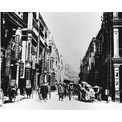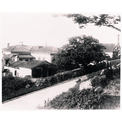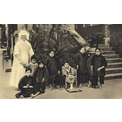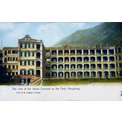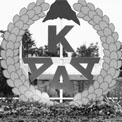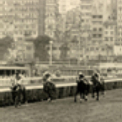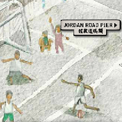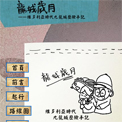 Collections
Collections Hong Kong, Benevolent City: Tung Wah and the Growth of Chinese Communities
Hong Kong, Benevolent City: Tung Wah and the Growth of Chinese Communities History of Tung Wah Services
History of Tung Wah Services Early Chinese Charitable and Relief Work
Early Chinese Charitable and Relief Work
1. Early Charitable and Relief Work in Hong Kong
In the early years of Hong Kong’s opening to foreign trade, most charities were founded by churches as part of their missionary work in China. Their charities included orphanages founded by the Sisters of Saint Paul de Chartres, the Canossian Missions and the Berlin Ladies Mission for China, as well as the clinic and hospital established by the Berlin Missionary Society in Wan Chai. The orphanages adopted foundlings, who were taught how to read and write and given a religious education. Later, the Hildesheimer Blindenmission founded a shelter in Western District that took in blind girls.
At the time, the Hong Kong Government hardly provided any assistance to needy Chinese people who could not fend for themselves. It offered only a small amount of financial support to shelters for the homeless and juvenile criminals. Members of the Chinese community could rely on native, clan, industry and neighbourhood organisations when they needed help finding work or solving other problems of daily life. These organisations, however, formed on the basis of geographical, blood-line, industry or neighbourhood relations, were limited in the scope of their services. Hong Kong’s first medical and charitable organisation with a mission to serve all Chinese residents only appeared in 1870 with the founding of the Tung Wah Hospital.
2. Mutual Assistance and Relief
In the early days, most of Hong Kong’s Chinese lived in Sheung Wan’s Tai Ping Shan District where hygiene was lacking and living conditions were tough. Some Chinese merchants acted on the belief that “all people are one’s own people” and provided assistance to those Chinese of the lower classes through kai-fong welfare and native associations. As early as 1866, Chinese people had proposed the building of a hospital offering Chinese medical services in Hong Kong, but the project came to fruition only in 1870 after the application by the founding directors of Tung Wah Hospital was approved. Other Chinese charitable organisations at the time included Po Leung Kung Kuk and Lok Sin Tong, which were founded in 1878 and 1880 respectively.
In the late 19th century, it was common in Guangdong province for people to be lured and then abducted for overseas labour. The Hong Kong Government did not intervene initially, but later enacted a law to stop these unfortunate incidents. Tung Wah joined the efforts to eliminate the “coolie trade”. In 1873, Tung Wah began hiring detectives to arrest such kidnappers and also began to take in rescued women and children. In late 1878, the gentry and merchants of Tung Wah helped found Po Leung Kung Kuk (present-day Po Leung Kuk), and loaned two of its buildings – the Ping On and Fook Sau buildings – to the Po Leung Kuk to be used as offices. In 1893, the Po Leung Kuk Incorporation Ordinance was enacted and the Po Leung Kuk took over the work of protecting women and children.
In 1910, Tung Wah established a temporary shelter to take in destitute refugees awaiting repatriation from Hong Kong. The shelter was closed in 1935 but reopened in 1941 and finally closed down in 1960.
3. Local Disaster Relief
In 1874, a furious typhoon hit Hong Kong and claimed over 2,000 lives in a mere 6 hours. Tung Wah joined the relief efforts in the aftermath of the calamity and buried 399 bodies on-site and in the Slaughter House Cemetery in Kennedy Town. This was the first time the Tung Wah Hospital participated in local disaster relief. In 1880, over 100 skeletons of the victims of the typhoon were discovered on Stonecutters Island. Supported by a generous donation from then Hong Kong Governor Sir John Pope Hennessy, Tung Wah buried the remains in Kellett Bay.
In 1918, some 600 people were killed in a blaze at the Happy Valley Racecourse. Tung Wah Hospital immediately sent medical personnel to care for the wounded. After the incident, it honoured the requests of families of the deceased by burying the victims in the Racecourse Fire Victims’ Cemetery in So Kon Po. Jiao rituals were performed for the victims so that their spirits could be redeemed. In the early 20th century, Tung Wah played a significant role in local disaster relief efforts, be it fund-raising, distribution of supplies or the offering of free coffins and funerals. After the Second World War, the Hong Kong Government established the Social Welfare Office and actively supported kai-fong welfare associations in an attempt to raise awareness of the importance of mutual assistance. As a result, a variety of social service organisations emerged one after the other, gradually diluting the leadership of the Tung Wah Group of Hospitals. Still, donations from Tung Wah continue to constitute a major source of relief funds.
4. Regional Hub and Disaster Relief in Mainland China
Over 5 million people died during a severe drought in North China between 1876 and 1879. Tung Wah directors Leung Wan Hon, Ko Mun Wo and O Chun Chit helped raise funds for disaster relief. In total, they remitted $160,000 collected in Hong Kong and Southeast Asia to mainland China. This was the first time Tung Wah had joined disaster relief efforts in mainland China. In 1878, Zeng Guoquan, the Military Governor of Shanxi province, bestowed Tung Wah a tablet that read ke guang de xin (compassion that extends to all). The following year, the tablet shen wei pu you (the god protects all) was awarded to Tung Wah by Qing Emperor Guangxu.
In 1885, the rivers of Xijiang and Beijiang in Guangdong province flooded. Tung Wah directors at the time, such as Ho Amei, collected over $46,000 by petitioning merchants in Hong Kong and abroad for donations. To commend these great efforts, Emperor Guangxu bestowed upon Tung Wah a second tablet which read wan wu xian li (all benefit from charitable deeds). In 1918, Tung Wah gave succour to victims of serious flooding in North China, and were awarded the tablet shan yu ren tong (charity brings happiness to the giver)” by President Feng Guozhang.
During the 20th century, Tung Wah offered assistance to people battered by the wars that continually ravaged China. In 1932, Shanghai became a raging battlefield. Tung Wah director Chan Lim Pak inspected the disaster area that year in person and raised funds among past and current directors. In 5 days he collected $96,000 with donations eventually totalling $320,000. After 1949, Tung Wah’s charitable and relief work in the mainland ceased, but efforts resumed after more than 40 years for the floods of 1991 and 1994. Over $6.9 million were raised in 1991 and $3 million in 1994.
5. Regional Hub and Disaster Relief to Overseas Chinese
In the 1860s, the treaties signed by the Qing government and foreign powers proclaimed that Chinese people could venture abroad to earn a living. Numerous Chinese, therefore, were recruited for agricultural, railway construction and mining work in countries like the Americas and Australia. Most of these workers travelled abroad via Hong Kong. Many of them made use of Hong Kong’s financial network to remit wages to their families back home, thus enabling them to maintain a close relationship with the city.
On 18 April 1906, an 8.3 magnitude earthquake in California claimed the lives of thousands of people and destroyed the homes of 250,000 residents. Tung Wah joined Guangren Shantang of Guangzhou in providing relief to Chinese people affected by the earthquake. Through pingdi (selling rice at a low price that was purchased at a higher price), loans, taking funds from the hospital budget as well as public fund-raising, Tung Wah managed to raise over $23,770 for the victims. On 1 September 1923, Japan’s Kanto area was struck by a 7.9 magnitude earthquake, which affected Tokyo, Kanagawa, Chiba and Shizuoka among other places. 150,000 people were killed, and over 2 million were made homeless. Tung Wah joined hands with the Chinese General Chamber of Commerce, Po Leung Kuk and the Kobe Chinese Association for disaster relief, launching a door-to-door fund-raising campaign and receiving those Chinese victims who had arrived in Hong Kong. Such overseas disaster relief efforts reaffirm the important role of Tung Wah as a bridge between mainland and overseas Chinese communities.
6. Tung Wah’s Relationship with the Hong Kong and Mainland Governments
The Hong Kong Government had hoped to appease the Chinese community through the founding of the Tung Wah Hospital. At the same time, it was concerned that such an organisation that transcended industry, blood-line, clan and geographical boundaries would grow in influence and eventually become imperium in imperio. It was also worried that Tung Wah would be used by the Qing government to threaten or harm the interests of foreign merchants in China. In 1884, when Hong Kong pier workers went on strike, the government assigned British soldiers patrol duties in the Tai Ping Shan District, and temporarily stationed some of them at the Tung Wah Hospital in a display of its might and authority. Later, the government criticised Tung Wah on the issue of Chinese medical practitioners as a way to tighten control over the hospital.
The Tung Wah Hospital board of directors consisted mostly of merchants with strong business connections with mainland China and countries of Southeast Asia. They also maintained a good relationship with the Chinese government and would receive mainland officials passing through Hong Kong. Thus, Tung Wah has consistently played the role of an organiser and provided a liaison for disaster relief in the mainland. After the founding of the Republic of China, Tung Wah retained its significance and continued to be recognised as the most representative Chinese organisation in Hong Kong.
7. Relief Work during the Japanese Occupation
After the Marco Polo Bridge Incident of 1937, a large number of refugees flocked to the south. To cope with the influx of refugees, the government designated the Civil Hospital, Victoria Prison Compound and the former Kowloon District Office, among other premises, as temporary shelters. In total, these facilities took in over 30,000 refugees. During this period, Tung Wah offered financial support to the refugees and helped send Chinese students and immigrants returning from Japan back to their hometowns. Tung Wah also reopened its own temporary shelter, and in compliance with the government’s request, managed the refugee camps, providing food and an array of relief services.
During Japanese Occupation period, the industrial sector went into decline. The Tung Wah Eastern Hospital was turned into a military hospital and all free schools were temporarily closed. The Tung Wah and Kwong Wah hospitals continued to serve the people, but as income dwindled, expenses could no longer be met. The group put its tenement properties on auction but no one was interested. In 1944, Tung Wah had used up all its reserves and was on the verge of closing because no merchant was willing to serve as director. In the end, Tung Wah appealed to the Chinese people of Hong Kong and managed to ease its financial difficulties with donations from the Japanese governor in Hong Kong and people from all walks of life of Hong Kong society.
8. From Relief Work to Social Service
Before and after 1949, a large number of military and civil officials of the Nationalist government fled to Hong Kong bringing with them their relatives. The Hong Kong government requested that Tung Wah provide provisional relief to these refugees. This process included performing registration and accommodating refugees in its temporary shelter. After the refugees were relocated from Mount Davis to Tiu Keng Leng, Tung Wah continued to help arrange their emigration to Taiwan. These efforts came to an end only in 1953 after all refugees had settled in Tiu Keng Leng.
From the 1950s to 1970s, most new immigrants from mainland China resided in squatter huts along the hillsides. As a result, every windstorm, fire or landslide would affect hundreds of people. At the time, Tung Wah remained at the front line of relief efforts, distributing food and clothing to the victims, even though planning and organisation had by that time already been taken over by the Social Welfare Office and kai-fong welfare associations. As social service organisations increased in type and number, Tung Wah no longer stood alone in its efforts of offering social services to the needy. After the government published its first white paper on social welfare policies in 1965, the number of emergency relief and social welfare facilities increased substantially. The authorities took on the responsibility of social service provision and, at the same time, subsidised voluntary organisations in providing related services. Thus, the Tung Wah Group of Hospitals became one of the government’s partners.
9. Tenement Properties and Charitable Service
The immense contribution made by the Tung Wah Group of Hospitals (TWGHs) to Hong Kong society has been possible largely due to generous donations from sponsors as well as revenues gleaned from tenement properties. Tung Wah acquired its first tenement property, 40 Wing Lok Fong (present-day Wing Lok Street) in 1873, and added over 10 buildings in Central and Sheung Wan in the 5 years that followed. By 1930, rental income from Tung Wah’s tenement properties had reached $113,651.
Apart from generating income, the acquisition of tenement property allowed Tung Wah to expand its boarding capacity. For example, in 1907 Tung Wah converted newly acquired flats in Po Yan Street and Po Leung New Street (present-day New Street) into the New Street Plague Ward. In 1930, a girls’ free school was opened also in Tung Wah tenement property. By year 2009/2010, Tung Wah owned and managed a total of 103 properties which generated some $336 million in rental income.
Generous sponsors have more than once donated properties to Tung Wah, reflecting society’s confidence in and support for Tung Wah.
10. Tung Wah Fund-raising Activities
In its early years, revenues of Tung Wah Hospital largely came from donations from guilds, merchant associations and its directors. When the economy was in a slump, however, donations shrank substantially. In order to overcome financial difficulties, Tung Wah has continuously expanded its scope of fund-raising and pioneered novel fund-raising ideas. It invited an opera troupe to stage a charity performance for the first time in 1913, and later in 1921, there was a charity performance by the celebrated Peking opera singer, Mei Lanfang. In 1929, the South China Athletic Association organised a charity football match for Tung Wah. Then, in 1934, Tung Wah organised a fund-raising carnival and sweepstakes. Other events included drama, circus performances, Flower Day (charity flower sale) and the Yulan Festival Charity Rally. People had only to pay for admission or subscribe to events to contribute to Tung Wah’s cause. In 1961, Tung Wah launched a charity raffle. The prizes for the lucky draw, which included cars and a whole block of flats, were donated by zealous sponsors. The tickets, meanwhile, were sold at $1 each and raised over $500,000.
Over the past several decades, Tung Wah’s fund-raising efforts have touched people from all walks of life through a variety of activities. Since 1979, Tung Wah has co-organised the annual Tung Wah Charity Gala with Television Broadcasts Limited to raise funds through televised programmes. The gala also comprises Public and Private Housing Estate Fund-raising Competitions, charity minibus and taxi rides and a market charity sale, which help drive funds to record highs every year. These fund-raising activities not only constitute an integral part of TWGHs’ major annual fund-raising events but also enhance the lives of Hong Kong citizens.
